My journey into the world of guitar synthesizers began in the 1970s, a time when I was transitioning from drums to guitar and working as an electronics apprentice. Synthesizers, with their fascinating sounds, immediately captured my imagination. However, the keyboard interface felt foreign to me as a guitarist. Early attempts to bridge the gap, like the Vox Organ Guitar, were intriguing but ultimately unreliable due to technical limitations. Despite these initial setbacks, my fascination with guitar synthesis persisted, and I closely followed its development. I even considered the EMS Synthi Hi-Fli, but soon realized it was more of a hyped-up effects unit than a true synthesizer.
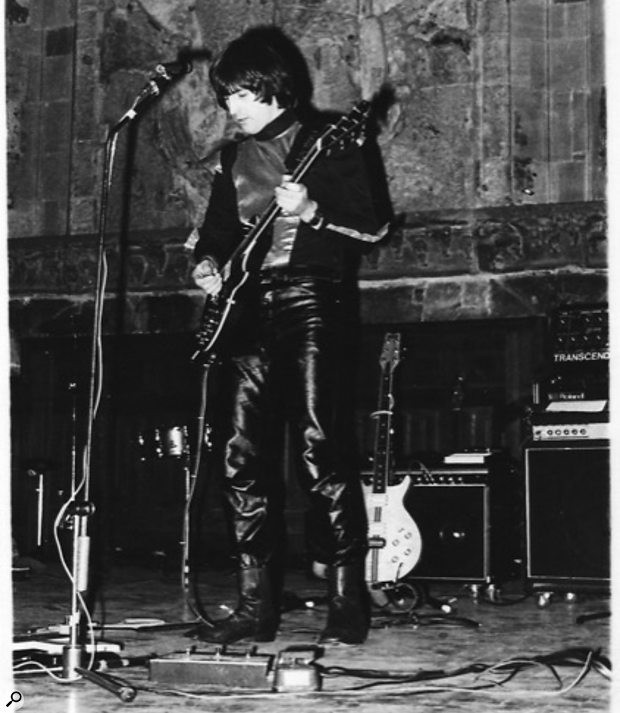 Paul White playing his Roland GR-500 guitar synth driving the Powertran Transcendent 2000 synth (far right).
Paul White playing his Roland GR-500 guitar synth driving the Powertran Transcendent 2000 synth (far right).
The author showcases his vintage Roland GR-500 guitar synthesizer alongside the Powertran Transcendent 2000 synth in his home studio.
The real turning point came in 1977 with the arrival of the ARP Avatar. Marketed as an enhanced ARP Odyssey adapted for guitar, it required a hex pickup to be installed on your own instrument. Excited by the possibilities, I purchased an Avatar, but its performance in reality didn’t live up to the advertised promises. Disappointed but undeterred, I returned it and exchanged it for the newly released Roland GR-500. I had witnessed Adrian Lee’s impressive demonstration of the GR-500 at the British Music Fair, and it sounded truly revolutionary. The GR-500 came as a complete package, featuring a dedicated Les Paul-style guitar, built by Ibanez, equipped with a hex pickup and a substantial multicore cable. This guitar was incredibly heavy, but as I was playing in a prog rock trio at the time, the GR-500 offered a way to create expansive, keyboard-like textures without needing an actual keyboard player. While the GR-500 had its quirks, it marked the true beginning of my long-lasting relationship with guitar synthesizers and their potential to blend Guitar And Synth sounds.
The Roland GR-500: Pioneering Guitar Synth Technology
The original Roland GR-500 utilized the vibrations of the guitar strings themselves, captured by the hex pickup, to generate its sounds. It employed a form of polyphonic fuzz for creating pseudo string pads and a monophonic lead voice complete with a resonant filter and envelope shaping capabilities. Additionally, it offered a bass sound derived from octave dividers applied to each of the lower strings. Shortly after its release, Roland upgraded the mono synth section to incorporate a Voltage Controlled Oscillator (VCO). This enhancement allowed for vibrato and portamento effects, and Roland generously offered a free upgrade to existing owners like myself.
The GR-500, a pioneering guitar and synth system, faced challenges including oscillator drift due to temperature instability.
However, the VCO upgrade brought its own set of challenges. Beyond a significant tracking delay for the VCO, temperature stabilization was lacking. Moving the synth from a cold vehicle into a warm venue often resulted in noticeable pitch drifting of the oscillator, even by the end of a performance. To mitigate this, I devised a DIY solution, crafting a small insulating jacket from expanded polystyrene to encase the VCO. Sonically, in its raw form, the GR-500 delivered sounds reminiscent of a budget monophonic synthesizer paired with a “polyphonic kazoo”. However, the application of chorus and echo effects dramatically transformed its character, unleashing its potential as a true “prog monster”. It was with this instrument that I composed tracks with evocative titles such as ‘Busfare For The Common Man’, fully embracing the unique soundscapes possible with guitar and synth fusion.
Roland also equipped the GR-500 with CV and Gate outputs – standard control interfaces in the pre-MIDI era. Capitalizing on this, I assembled a Powertran Transcendent 2000 monophonic synthesizer from a kit and positioned it behind the GR-500 unit. A simple modification allowed me to control the vibrato depth of the Transcendent 2000 using a Coloursound volume pedal, which I further modified with a spring to ensure it returned to the ‘no vibrato’ position when released. The combined output of this formidable setup, which I affectionately nicknamed “Orac” after the sentient computer from the Blake’s Seven science fiction television series, was routed through a DIY keyboard combo amplifier. I incorporated an EHX Clone Theory chorus and a Carlsbro BBD echo box into this chain. Simultaneously, the direct guitar signal, which I preferred over the GR-500’s pickup, was routed through a separate, conventional guitar amplifier. I replaced the GR-500 pickup with a DiMarzio humbucker and accessed its output from a dedicated jack.
Playing the GR-500 required a clean and precise technique to avoid unwanted pitch glitches and swoops. Employing slow attack synth sounds helped to mask the inherent tracking latency. However, the instrument offered unique advantages, notably infinite sustain on any fretted note. This was achieved through an ingenious system that fed signals from six amplifiers into each of the six guitar strings at the bridge end, where insulators isolated the strings from each other. The frets were grounded, so when a string was fretted, current flowed. A magnet, positioned where a neck pickup would typically be, interacted with the current, sustaining the string vibration according to Faraday’s Law. This sustain was sufficient for the synth’s pitch tracker to function reliably, while remaining subtle enough not to significantly interfere with normal guitar playing.
I continued to use this somewhat cumbersome rig until the Roland GR-300 was announced in 1979. Naturally, I acquired one immediately. Like its predecessor, the GR-300 required a Roland guitar with a built-in hex pickup, but the included Ibanez-made guitar was a significant improvement – lighter and more comfortable than the GR-500’s instrument. While some consider the GR-300 to be the first truly playable guitar synth, I had already created numerous recordings using the GR-500, demonstrating its usability. Interestingly, I later re-purchased my original GR-500, but after a brief revisit, decided to sell it again.
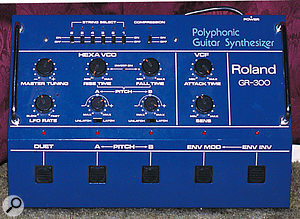 Roland GR-300 polyphonic guitar synthesiser floor unit.
Roland GR-300 polyphonic guitar synthesiser floor unit.
The Roland GR-300 guitar synthesizer floor unit, featuring a bright blue finish and innovative polyphonic capabilities.
The GR-300, with its striking bright blue floor unit design, incorporated sophisticated circuitry. It directly utilized the signal from the guitar strings to reset a ramp generator, producing a sawtooth waveform. Phase-locked loop oscillator circuitry was employed for pitch-shifting, vibrato, and pitch glide effects. Basic envelope filtering was included, and a capacitive sensor plate beneath the bridge pickup allowed for touch-controlled vibrato. Another sensor plate on top of the pickup triggered pitch glide, but I often activated it unintentionally, leading me to cover it with tape. Similar to the GR-500, the GR-300 lacked onboard effects, resulting in a somewhat sterile sound until external chorus and delay were added. While the GR-300 was more user-friendly and eliminated the latency issues of the GR-500, it didn’t possess the same dramatic sonic impact. It also lacked a dedicated mono voice for soloing over sustained chords and the infinite sustain feature of the GR-500. The GR-300’s sound palette was primarily focused on pseudo-string and pseudo-brass timbres, but its ease of playing and responsive tracking made it a reliable performance tool. I used the GR-300 extensively in live performances, making frequent use of the touch vibrato feature.
The Rise of MIDI and Polyphonic Guitar Synths
The mid to late 1980s witnessed a surge of interest in guitar synthesizers, with many believing they were poised to become the next major trend in music technology. Sound On Sound magazine, where I worked, had the opportunity to examine innovative and often expensive instruments like the Synthaxe, with its unique angled neck. The Synthaxe employed separate strings for fretting and picking, precluding its use as a conventional guitar, and also included a set of keys on the body. We also encountered the Yamaha G-10, strung with strings of equal thickness, the Casio MIDI Guitar, and various other approaches to guitar synthesis. Among these, only the Casio MIDI Guitar was based on a playable, standard guitar, and many of these units remain in use today. While other instruments aimed for guitarist-friendly interfaces, they were, in essence, guitar-shaped MIDI controllers rather than true guitars. For those comfortable with a guitar-like MIDI controller that isn’t actually a guitar, options like the Starr Labs Ztar or the You Rock Guitar offer compelling alternatives.
Roland, commendably, remained committed to integrating synth capabilities into genuine guitars. I recall reviewing the Roland GR-700 in 1985, their first guitar synth to incorporate MIDI. It was paired with a futuristic silver guitar, equipped with a damping bar extending from the body to the headstock, and its sound engine was derived from the JX-3P synthesizer. I famously described its appearance as resembling a ‘Dalek’s handbag,’ a description that, to my surprise, seems to have endured.
The original GK-1 hex pickup controller, a crucial component for Roland’s guitar synth systems.
In 1986, Roland transitioned from dedicated synth guitars to the GK pickup system. This pivotal shift allowed musicians to either purchase “Roland Ready” guitars with pre-installed hex pickups or add a GK pickup to their existing guitars. Other manufacturers, including Godin, Washburn, Fender, and Ibanez, also began producing guitars with integrated hex pickup systems compatible with the now-standard Roland 13-pin DIN connection. Yamaha also offered a standalone guitar-to-MIDI converter rack unit, the G50. The advent of MIDI was a significant advancement, enabling guitar synths to control external sound modules and access a vastly expanded range of sounds. In 1992, Roland introduced the GK-compatible GR-1, which utilized sample-based sounds. I recall owning a GR-1 for a period. While a slight tracking delay and occasional spurious notes due to less-than-perfect playing technique were still present, it performed remarkably well considering its early development.
Affordable and Modern Guitar Synth Solutions: GR-09, VG-99, and Beyond
It wasn’t until the release of the affordable Roland GR-09 floor unit in 1994 that I acquired another guitar synth. The GR-09 offered decent tracking, although not as fast as later models, and came with a collection of usable sample-based sounds, primarily in the style of Roland’s Sound Canvas GM patches. When the more advanced GR-33 was released six years later, featuring enhanced capabilities and improved sounds, I upgraded and still retain it, though it resides in my ‘cupboard of eternal darkness’, rarely seeing use. In recent years, I’ve largely avoided using MIDI guitar systems outside of the studio. The setup complexity, requiring separate amplification and additional pedals for control and volume adjustment, has become cumbersome for live performance. Despite improvements in tracking speed, clean playing remains essential to prevent unwanted random pitch artifacts. While newer models like the Roland GR-55 emerged, I resisted upgrading until more recent innovations caught my attention.
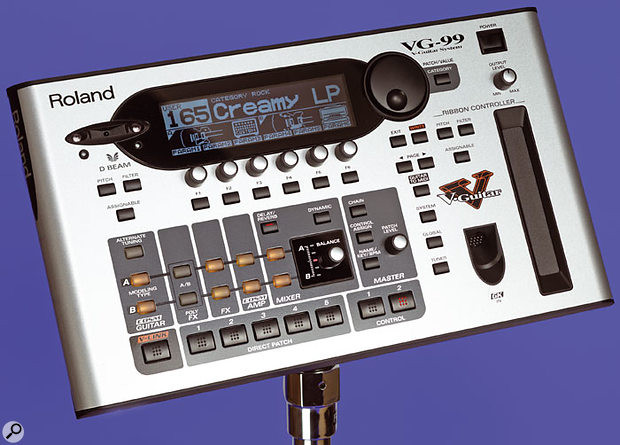 The V-Guitar Synthesizer module, the VG-99.
The V-Guitar Synthesizer module, the VG-99.
The Roland VG-99 V-Guitar Synthesizer module, offering a blend of guitar modeling and synth-like sounds.
I did, however, incorporate a Roland VG-99 into my live setup for a while, and it remains a valuable tool in my studio. Although not strictly a synthesizer, the VG-99 possesses synth-like characteristics. Evolving from the earlier VG-8 and VG-88, it still relies on a GK hex pickup. The VG-99 combines guitar and effects modeling with HRM (Harmonic Restructure Modelling) synthesis, which manipulates the harmonic structure of the incoming guitar signal to create synth-like sounds. Combined with its onboard effects, the VG-99 is capable of producing organic and expressive tones that bridge the gap between guitar and synthesizer.
A significant breakthrough occurred recently, enabling polyphonic pitch extraction from a standard guitar output, opening new possibilities for guitar and synth integration.
Polyphonic Revolution and Modern Guitar Synth Pedals
While guitar synth pedals and compact guitar-to-MIDI converters have been available for some time, they traditionally required a monophonic input for accurate tracking. Chords would often confuse these systems. A paradigm shift occurred with the advent of polyphonic pitch extraction from a standard guitar output. TC Electronic’s Polytune tuner utilized this principle to display the tuning of all six guitar strings simultaneously. Electro-Harmonix further capitalized on this technology, following their HOG and POG pedals with the B9 organ pedal – a polyphonic processor capable of producing convincing tone wheel organ sounds from a standard guitar input. This was followed by other pedals in the “9 Series,” offering Mellotron, keyboard, and synth emulations. While the inner workings remain somewhat proprietary, these pedals appear to employ some form of polyphonic pitch extraction to control filters applied to individual notes.
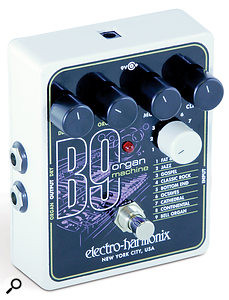 Electro-Harmonix B9 Organ Machine
Electro-Harmonix B9 Organ Machine
The Electro-Harmonix B9 Organ Machine, a polyphonic pedal that emulates classic organ sounds using a standard guitar input.
Currently, I incorporate an Electro-Harmonix B9 organ pedal into my live performances, blending it with my guitar sound. However, optimizing its performance proved to be more involved than initially anticipated. Organs are not velocity-sensitive, necessitating a compressor pedal before the B9 to even out the dynamics. A Leslie-type rotary speaker effect after the B9 is also crucial for achieving a truly realistic organ sound. I opted for a Neo Mini Vent, which accurately recreates the Leslie effect, including the speed-up and slow-down transitions. Controlling the Leslie speed dynamically during songs became an integral part of the performance, requiring me to add a stool to my setup for seated playing. A volume pedal was also necessary to blend the organ sound in and out as needed. To achieve full bandwidth, stereo organ sound, I route the Leslie output directly to the PA system, adding to the cable count. Ultimately, the B9 and its associated gear occupied a significant portion of my pedalboard, but the sonic results justified the complexity. On the software side, Jam Origin’s MIDI Guitar software demonstrates the viability of real-time, low-latency, polyphonic pitch-to-MIDI conversion from a conventional guitar. MIDI Guitar, available for macOS and Windows, remains somewhat of an industry secret, but its performance, underpinned by machine learning, is remarkably impressive. As digital signal processing continues to advance, this type of technology is only poised to become faster and more accurate. Even currently, it’s highly usable, and I frequently utilize Jam Origin’s MIDI Guitar in the studio when recording software instrument parts. It streamlines the process, eliminating the need for specialized hardware or guitar changes. The key is to feed it a clean guitar signal, avoiding excessive effects. Any unintended notes from less-than-perfect playing are easily corrected in a DAW’s piano roll editor, as they are typically short in duration and low in velocity.
Boss SY Series: Analogue-Inspired Guitar Synths for the Modern Player
Boss, Roland’s guitar-focused division, combined guitar effects with their polyphonic pitch processing technology to create the Boss SY-300. This compact pedal unit produces analogue-style synth sounds from a standard guitar input, harking back to the simplicity of the GR-300 but with expanded tonal versatility and without requiring a special guitar or GK pickup. The SY-300 effectively provides guitarists with access to synth-like pad, lead, and bass sounds. I have one in my studio and use it for ambient music projects, often combining it with plug-in effects, eBow techniques, or processing slide guitar for unique textures. The SY-300’s built-in effects section is also highly versatile, and many of its most compelling sounds blend synthesis and processed guitar tones. A significant advantage is the included software editor, which simplifies sound creation and allows users to download sounds created and shared by others.
Boss’s SY-1000 guitar synth, a powerhouse of guitar and synth sound design.
At NAMM 2020, Boss unveiled the SY-1000. While I don’t yet own one, having reviewed it for Sound On Sound, it’s only a matter of time before I succumb to its allure. Hex pickups still offer the fastest and most accurate pitch tracking due to superior string separation, and the SY-1000 leverages hex pickups to maximize its performance, although many of its sound engines also function with a standard guitar input. The SY-1000 can be described as an ‘SY-300 on steroids’, featuring a new Oscillator synth engine and an expanded suite of flagship Boss effects.
The SY-1000 review in Sound On Sound April 2020 issue provides a comprehensive overview, but key highlights include its patch architecture, which allows for combining up to three synth voices and one processed guitar voice with extensive routing and effects options. This enables the creation of massive, atmospheric sounds with an analogue character. When used with a GK pickup, the Oscillator synth voice becomes a multi-waveform polysynth with vibrato, portamento, and the expected envelope, filter, and sequencer capabilities. Personally, I find it particularly effective when set to a single voice, allowing for lead lines to be played over chordal pads, reminiscent of my early experiences with the GR-500. The SY-1000’s tracking speed is impressive, and its MIDI output is faster and more reliable than previous Roland/Boss guitar synths, making it well-suited for controlling virtual instruments or external sound modules, further blurring the lines between guitar and synth.
This overview represents a condensed account of my personal journey with guitar synths in both studio and live contexts. It is by no means exhaustive, and it’s important to acknowledge the contributions of Fishman, who have also significantly advanced hex pickup technology (see the Sound On Sound review of the Fishman TriplePlay). One thing is certain: my exploration of the ever-evolving world of guitar and synth is far from over.
The Enduring Legacy of the GK Pickup
Roland’s add-on hex pickup, now in its third iteration as the GK-3, continues to utilize the same fundamental principle. The GK pickup itself is remarkably narrow and incorporates humbucking technology to minimize interference that could disrupt the pitch tracking in connected GK-compatible devices. It connects to a compact control unit that can be conveniently mounted to the guitar body using either double-sided adhesive tape or a small bracket secured by the strap button for non-permanent attachment. The pickup itself can also be attached using adhesive pads and spacers or more permanently with small wood screws. For guitars with Les Paul-style bridges, an adapter plate is available, utilizing the existing bridge pillars for secure mounting.
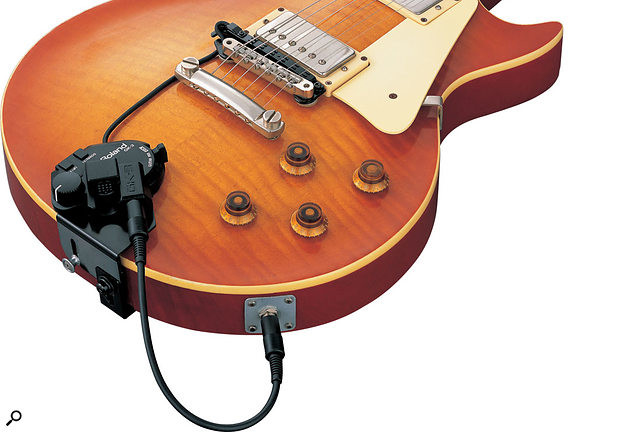 Roland GK-3 hex pickup.
Roland GK-3 hex pickup.
The Roland GK-3 hex pickup, a refined and versatile solution for integrating guitar and synth technologies.
The signal from the GK pickup is transmitted to the control unit, which features a 13-pin DIN connector for connecting to the receiving device. A link jack allows the regular guitar output to be routed through the controller, down the 13-pin cable, and to the receiving device, most of which include a Thru connector to send the guitar signal to a separate amplifier. This configuration minimizes cable clutter and offers a convenient Guitar/Mix/GK-only switch on the controller. A rotary control provides remote volume adjustment for the connected GK-compatible device, and two buttons can be assigned to patch up/down selection or other functions depending on the connected device.
Most six-string guitars, including acoustic models (bass versions are also available), are compatible with GK pickups. Telecaster-style ‘ashtray’ bridge plates are an exception due to the requirement for close pickup proximity to the bridge. Proper adjustment of the pickup-to-string distance, using the included shims and following the instruction manual, is crucial. The GK-3 also features a physical curvature adjustment to match the fingerboard radius, ensuring optimal performance and seamless integration of guitar and synth technologies.
